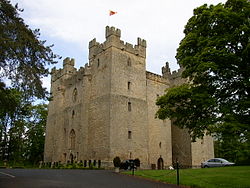Langley, Northumberland
| Langley | |
| Northumberland | |
|---|---|
 Langley Castle | |
| Location | |
| Grid reference: | NY825615 |
| Location: | 54°56’53"N, 2°16’30"W |
| Data | |
| Post town: | Hexham |
| Postcode: | NE47 |
| Dialling code: | 01434 |
| Local Government | |
| Council: | Northumberland |
| Parliamentary constituency: |
Hexham |
Langley is a small village in Northumberland, located to the west of Hexham and south of the valley of the River South Tyne.
The village is on the A686 about three miles south of Haydon Bridge. The skyline of Langley is still dominated by the lead smelting chimney with its underground flue leading to the old smelt works, now a sawmill, where the old tracks for the ore wagons can still be seen. There are currently just over 100 residents.
Sights about the village
Langley Castle is a restored mediæval tower house, and a Grade I listed building. It was built in the middle of the 14th century as a great H-shaped tower of four storeys. Before this the site was the seat of the Barons of Tynedale in the 12th century, from whom descend the Tyndall family. It was attacked and severely damaged in 1405 by the forces of King Henry IV in the campaign against the Percys and Archbishop Scrope. It remained as a ruin until it was bought and restored by a local historian, Cadwallader Bates, in the late 19th century. He died in 1902 and his wife Josephine continued the restoration. After she died in 1932 the building remained empty until it was used as a barracks in the Second World War, after which it was used as a girls' school.[1][2] Inside Langley Castle are some of the best preserved Garderobes in Britain and these can be viewed from the main staircase. It has since been converted into a luxury hotel.
Staward Manor has an old Roman altar stone and, in 1999, a Roman road was discovered nearby.
Staward Gorge is a Victorian garden in a gorge of the River Allen, now owned by the National Trust. There is a mediæval Pele tower here and the garden is an area of Special Scientific Interest, and the most northerly habitat of dormice in Britain.
The Allen Banks beside the garden are likewise owned by the National Trust. Here visitors are likely to encounter deer and red squirrels.
Miscellany
Catherine Cookson, the author, lived in the village for many years.
See also
Outside links
| ("Wikimedia Commons" has material about Langley, Northumberland) |
References
- ↑ Fry, Plantagenet Somerset (1980). The David & Charles Book of Castles. David & Charles. pp. 251. ISBN 0-7153-7976-3.
- ↑ Hodgson, John (1840). A History of Northumberland. pp. Vol 3:pp 367–8.